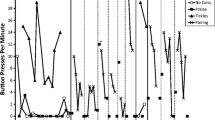Abstract
We repeatedly paired preferred stimuli with known establishing properties and poster boards (i.e., neutral stimuli) to examine whether these poster boards would acquire the effects of a conditioned establishing operation in five children with autism. Following pairing, the poster boards, which had been previously shown to be neutral, increased immediate or subsequent engagement in stereotypy for three of five participants. The results suggest that it is possible to condition establishing operations for stereotypy and that this process may occur inadvertently. We discuss the potential clinical implications of the results, as well as the need for future research to replicate our findings.


Similar content being viewed by others
References
Adelinis, J. D., Piazza, C. C., Fisher, W. W., & Hanley, G. P. (1997). The establishing effects of client location on self-injurious behavior. Research in Developmental Disabilities, 18, 383–391. doi:10.1016/S0891-4222(97)00017-6.
Carter, S. L., Devlin, S. R., Doggett, A., Harber, M. M., & Barr, C. (2004). Determining the influence of tangible items on screaming and handmouthing following an inconclusive functional analysis. Behavioral Interventions, 19, 51–58. doi:10.1002/bin.150.
Critchfield, T. S. (2011). Translational contributions of the experimental analysis of behavior. The Behavior Analyst, 34, 3–17.
Friman, P. C. (2000). “Transitional objects” as establishing operations for thumb sucking: a case study. Journal of Applied Behavior Analysis, 33, 507–509. doi:10.1901/jaba.2000.33-507.
Lang, R., O’Reilly, M., Sigafoos, J., Lancioni, G. E., Machalicek, W., Rispoli, M., et al. (2009). Enhancing the effectiveness of a play intervention by abolishing the reinforcing value of automatically reinforced behavior: a pilot study. Journal of Applied Behavior Analysis, 42, 889–894. doi:10.1901/jaba.2009.42-889.
Lang, R., O’Reilly, M., Sigafoos, J., Machalicek, W., Rispoli, M., Lancioni, G. E., et al. (2010). The effects of an abolishing operation intervention component on play skills, challenging behavior, and automatically reinforced behavior. Behavior Modification, 34, 267–289. doi:10.1177/0145445510370713.
Lanovaz, M. J., Rapp, J. T., & Fletcher, S. E. (2010). Expanding functional analysis of automatically reinforced behavior using a three-component multiple-schedule. European Journal of Behavior Analysis, 11, 17–27.
Laraway, S., Snycerski, S., Michael, J., & Poling, A. (2003). Motivating operations and terms to describe them: some further refinements. Journal of Applied Behavior Analysis, 36, 407–414. doi:10.1901/jaba.2003.36-407.
Lerman, D. C. (2003). From the laboratory to community application: transitional research in behavior analysis. Journal of Applied Behavior Analysis, 36, 415–419. doi:10.1901/jaba.2003.36-415.
McGill, P. (1999). Establishing operations: implications for the assessment, treatment, and prevention of problem behavior. Journal of Applied Behavior Analysis, 32, 393–418. doi:10.1901/jaba.1999.32-393.
Michael, J. (1993). Establishing operations. The Behavior Analyst, 16, 191–206.
Mudford, O. C., Taylor, S. A., & Martin, N. T. (2009). Continuous recording and interobserver agreement algorithms reported in the Journal of Applied Behavior Analysis (1995–2005). Journal of Applied Behavior Analysis, 42, 165–169. doi:10.1901/jaba.2009.42-165.
Piazza, C. C., Adelinis, J. D., Hanley, G. P., Goh, H., & Delia, M. D. (2000). An evaluation of the effects of matched stimuli on behaviors maintained by automatic reinforcement. Journal of Applied Behavior Analysis, 33, 13–27. doi:10.1901/jaba.2000.33-13.
Rapp, J. T. (2004). Effects of prior access and environmental enrichment on stereotypy. Behavioral Interventions, 19, 287–295. doi:10.1002/bin.166.
Rapp, J. T. (2005). Some effects of audio and visual stimulation on multiple forms of stereotypy. Behavioral Interventions, 20, 255–272. doi:10.1002/bin.196.
Rapp, J. T. (2007). Further evaluation of methods to identify matched stimulation. Journal of Applied Behavior Analysis, 40, 73–88. doi:10.1901/jaba.2007.142-05.
Rapp, J. T. (2008). Conjugate reinforcement: a brief review and suggestions for applications to the assessment of automatically reinforced behavior. Behavioral Interventions, 23, 113–136. doi:10.1002/bin.259.
Rapp, J. T., Vollmer, T. R., St. Peter, C., Dozier, C. L., & Cotnoir, N. M. (2004). Analysis of response allocation in individuals with multiple forms of stereotyped behavior. Journal of Applied Behavior Analysis, 37, 481–501. doi:10.1901/jaba.2004.37-481.
Rapp, J. T., Swanson, G., Sheridan, S., Enloe, K., Maltese, D., Sennott, L., et al. (2013). Immediate and subsequent effects of matched and unmatched stimuli on targeted vocal stereotypy and untargeted motor stereotypy. Behavior Modification, 37, 543–567. doi:10.1177/0145445512461650.
Rosales, R., & Rehfeldt, R. A. (2007). Contriving transitive conditioned establishing operations to establish derived manding skills in adults with severe developmental disabilities. Journal of Applied Behavior Analysis, 40, 105–121. doi:10.1901/jaba.2007.117-05.
Shillingsburg, M. A. (2005). The use of the establishing operation in parent-child interaction therapies. Child & Family Behavior Therapy, 26(4), 43–58. doi:10.1300/J019v26n04_03.
Van Camp, C. M., Lerman, D. C., Kelley, M. E., Roane, H. S., Contrucci, S. A., & Vorndran, C. M. (2000). Further analysis of idiosyncratic antecedent influences during the assessment and treatment of problem behavior. Journal of Applied Behavior Analysis, 33, 207–221. doi:10.1901/jaba.2000.33-207.
Author Note
Portions of this project were supported by a grant provided to the second and third authors by Autism Speaks #2852.
Author information
Authors and Affiliations
Corresponding author
Rights and permissions
About this article
Cite this article
Lanovaz, M.J., Rapp, J.T., Long, E.S. et al. Preliminary Effects of Conditioned Establishing Operations on Stereotypy. Psychol Rec 64, 209–216 (2014). https://doi.org/10.1007/s40732-014-0027-x
Published:
Issue Date:
DOI: https://doi.org/10.1007/s40732-014-0027-x




